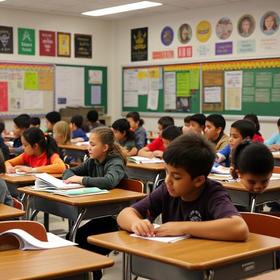Top Rankings
Willard R-II School District ranks among the top 20% of public school district in Missouri for:
Category
Attribute
Overall Rank
Highest overall rank (Top 20%)
Math Proficiency
Highest math proficiency (Top 20%)
Graduation Rate
Highest graduation rate (Top 5%)
Community Size
Largest student body (number of students) (Top 1%)
For the 2025-26 school year, there are 5 public preschools serving 1,865 students in Willard R-II School District. This district's average pre testing ranking is 9/10, which is in the top 20% of public pre schools in Missouri.
Public Preschools in Willard R-II School District have an average math proficiency score of 48% (versus the Missouri public pre school average of 35%), and reading proficiency score of 50% (versus the 37% statewide average).
Minority enrollment is 14% of the student body (majority Hispanic), which is less than the Missouri public preschool average of 36% (majority Black).
Overview
This School District
This State (MO)
# Schools
9 Schools
733 Schools
# Students
4,648 Students
201,896 Students
# Teachers
351 Teachers
18,018 Teachers
Student-Teacher Ratio
13:1
13:1
Student By Grade
District Rank
Willard R-II School District, which is ranked within the top 20% of all 553 school districts in Missouri (based off of combined math and reading proficiency testing data) for the 2022-2023 school year.
The school district's graduation rate of 96% has decreased from 97% over five school years.
Overall District Rank
#98 out of 555 school districts
(Top 20%)
(Top 20%)
Math Test Scores (% Proficient)
48%
40%
Reading/Language Arts Test Scores (% Proficient)
49%
43%
Science Test Scores (% Proficient)
43%
38%
Graduation Rate
96%
90%
Students by Ethnicity:
Diversity Score
0.27
0.54
% American Indian
1%
n/a
% Asian
1%
2%
% Hispanic
6%
9%
% Black
4%
20%
% White
85%
64%
% Hawaiian
n/a
n/a
% Two or more races
3%
5%
All Ethnic Groups
District Revenue and Spending
The revenue/student of $11,687 in this school district is less than the state median of $15,081. The school district revenue/student has stayed relatively flat over four school years.
The school district's spending/student of $11,406 is less than the state median of $13,908. The school district spending/student has stayed relatively flat over four school years.
Total Revenue
$54 MM
$13,447 MM
Spending
$53 MM
$12,401 MM
Revenue / Student
$11,687
$15,081
Spending / Student
$11,406
$13,908
Best Willard R-II School District Public Preschools (2025-26)
School
(Math and Reading Proficiency)
(Math and Reading Proficiency)
Location
Quick Facts
Rank: #11.
Willard North Elementary School
(Math: 65-69% | Reading: 55-59%)
Rank:
Rank:
10/
Top 10%10
409 Farmer Rd
Willard, MO 65781
(417) 742-2597
Willard, MO 65781
(417) 742-2597
Gr: PK-4 | 318 students Student-teacher ratio: 11:1 Minority enrollment: 8%
Rank: #22.
Willard East Elementary School
(Math: 55-59% | Reading: 55-59%)
Rank:
Rank:
9/
Top 20%10
518 Kime
Willard, MO 65781
(417) 742-4639
Willard, MO 65781
(417) 742-4639
Gr: PK-4 | 332 students Student-teacher ratio: 13:1 Minority enrollment: 3%
Rank: #33.
Willard Central Elementary School
(Math: 50-54% | Reading: 55-59%)
Rank:
Rank:
9/
Top 20%10
2625 N Farm Rd 101
Springfield, MO 65802
(417) 831-4440
Springfield, MO 65802
(417) 831-4440
Gr: PK-4 | 402 students Student-teacher ratio: 13:1 Minority enrollment: 8%
Rank: #44.
Willard Orchard Hills Elementary School
(Math: 35-39% | Reading: 40-44%)
Rank:
Rank:
5/
Bottom 50%10
4595 Farm Road 140
Springfield, MO 65802
(417) 869-0600
Springfield, MO 65802
(417) 869-0600
Gr: PK-4 | 404 students Student-teacher ratio: 12:1 Minority enrollment: 24%
Rank: #55.
Willard South Elementary School
(Math: 30-34% | Reading: 40-44%)
Rank:
Rank:
5/
Bottom 50%10
4151 W Division
Springfield, MO 65802
(417) 862-6308
Springfield, MO 65802
(417) 862-6308
Gr: PK-4 | 409 students Student-teacher ratio: 12:1 Minority enrollment: 25%
Recent Articles

How Public Schools Support Students on Free / Reduced-Lunch Programs
Explore how U.S. public schools support students eligible for free or reduced-price lunch through nutrition, academic, and wraparound services in 2025.

Hidden Costs of Public Schools: Fees, Supplies & Extras
Explore the hidden costs in public schools—fees, supplies, extracurriculars—and how parents can plan for them in 2025.

Public School Funding 2025: What Families Should Know
Essential insights on public school funding in 2025—how it works, what’s changing, and what families should know to stay ahead.




